Helping Your Child Thrive: Practical Tips for Supporting Fine Motor Skill Development

As parents, we want to see our children grow, develop, and reach their full potential. One area of growth that is often overlooked but crucial for independence is the development of fine motor skills. These skills involve the coordination of small muscles, particularly in the hands and fingers, allowing children to perform tasks like holding a pencil, tying shoes, or buttoning a shirt.
In some cases, children may experience delays or challenges in developing these essential skills. If your child is struggling with fine motor tasks, it could be beneficial to seek professional support, such as occupational therapy services designed to address developmental needs and help them progress.
Understanding Fine Motor SkillsFine motor skills are essential for everyday tasks, especially as children grow and become more independent. These skills allow kids to:
Grasp and manipulate objectsWrite, draw, or colorUse utensils like forks and spoonsFasten buttons, zippers, and snapsTie shoelacesTurn pages in a bookDevelopment of these skills begins at an early age, and as children progress, their fine motor abilities should grow stronger. However, some children may need additional support, especially if they experience delays or difficulties in this area.
Signs Your Child May Need Fine Motor SupportBefore we dive into tips, it’s important to understand when your child might benefit from extra help. If your child struggles with any of the following tasks, it may be a sign they need support in developing fine motor skills:
Difficulty holding writing tools like pencils or crayonsTrouble using scissors or glueProblems with tasks like dressing or feeding themselvesMessy handwritingFrustration with small, intricate tasks like puzzles or building blocksPractical Tips for Supporting Fine Motor Development at HomeWhile every child develops at their own pace, there are several fun and practical ways parents can encourage fine motor skill development at home. Here are some activities and strategies that can help.
1. Encourage Drawing, Coloring, and WritingOne of the easiest ways to build fine motor skills is through drawing, coloring, and writing. These activities promote hand strength, dexterity, and coordination.
Offer different tools: Provide crayons, pencils, markers, and chalk in various sizes to encourage grip variety.Coloring books and free drawing: These allow children to explore their creativity while practicing controlled hand movements.Pre-writing exercises: Tracing letters or shapes can help younger children develop hand control before they start formal writing.2. Engage in Play Dough and Clay ActivitiesPlaying with materials like play dough or clay is excellent for strengthening the muscles in the hands and fingers. These materials offer resistance, which promotes strength and coordination.
Roll and flatten dough: Encourage your child to roll the dough into long “snakes” or flatten it into pancakes, which requires controlled finger pressure.Cutting shapes: Use cookie cutters or plastic tools to cut the dough into shapes, practicing precision and control.3. Practice with ScissorsLearning how to cut with scissors is a classic fine motor activity that many children find challenging. Start with safety scissors and simple materials like paper or play dough, then gradually move to more complex tasks.
Start with straight lines: Before attempting circles or more complicated shapes, let your child practice cutting straight lines.Supervision is key: Make sure to supervise closely, especially when using scissors for the first time, to ensure safety and correct technique.4. Use Tweezers, Tongs, and Small ToolsManipulating small objects with tweezers or tongs can significantly improve a child’s fine motor coordination and hand strength.
Sorting games: Use tweezers or tongs to pick up small objects like pom-poms or beads and sort them into containers.Incorporate into daily activities: Let your child help in the kitchen by using tongs to move vegetables or serving utensils at mealtime.5. Play Games That Involve Finger DexterityMany classic games and toys are designed to improve fine motor skills while providing entertainment.
Building blocks: Toys like LEGO or wooden blocks encourage precise finger movements and hand-eye coordination.Board games: Games that require pieces to be moved, such as chess, checkers, or Jenga, promote delicate, controlled hand movements.6. Button, Zip, and Tie PracticeGetting dressed independently is a huge milestone for many children. Tasks like buttoning, zipping, and tying shoes all require fine motor skills. Allow your child to practice these tasks on their clothing or with practice boards designed for buttoning and lacing.
Practice boards: These are available online or in stores and come with zippers, buttons, and laces for kids to practice on.Patience and repetition: While these tasks can be frustrating for some children, consistent practice builds confidence and skill.7. Introduce Puzzles and Shape SortingPuzzles and shape-sorting games are not only great for cognitive development but also excellent for fine motor skill-building. Handling puzzle pieces or manipulating shapes into correct spaces requires precision and dexterity.
Age-appropriate puzzles: Start with larger pieces for younger children and gradually introduce smaller, more intricate puzzles as their skills improve.When to Seek Professional HelpIf your child is consistently struggling with fine motor tasks despite practicing at home, it may be time to consider professional support. Occupational therapists work with children one-on-one or in group settings to focus on specific challenges, using fun and engaging activities that align with your child’s needs. This extra guidance can make a significant difference in their development, helping them thrive both at school and at home.
Fine motor skills are crucial for a child’s independence and daily functioning. By integrating fun, hands-on activities into your child’s routine, you can support their growth and development in a way that feels natural and enjoyable. Try incorporating some of the tips and activities from this article and watch as your child’s fine motor skills improve over time!
The post Helping Your Child Thrive: Practical Tips for Supporting Fine Motor Skill Development appeared first on Geek Mamas .



